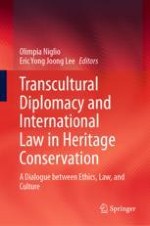2021 | OriginalPaper | Chapter
International Legal Instruments as a Means for the Protection of Cultural Heritage
Author : Tullio Scovazzi
Published in: Transcultural Diplomacy and International Law in Heritage Conservation
Publisher: Springer Singapore
Activate our intelligent search to find suitable subject content or patents.
Select sections of text to find matching patents with Artificial Intelligence. powered by
Select sections of text to find additional relevant content using AI-assisted search. powered by
